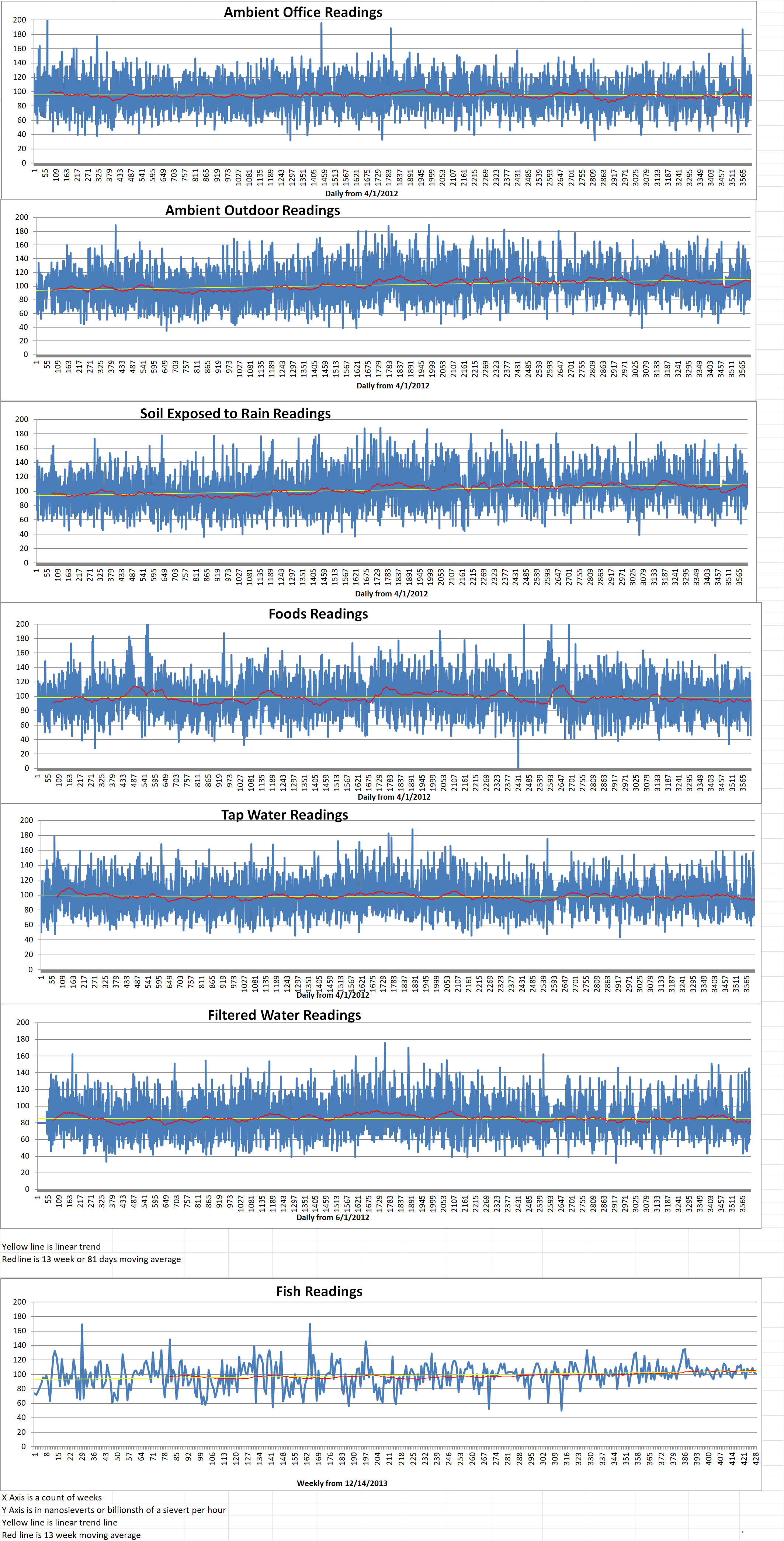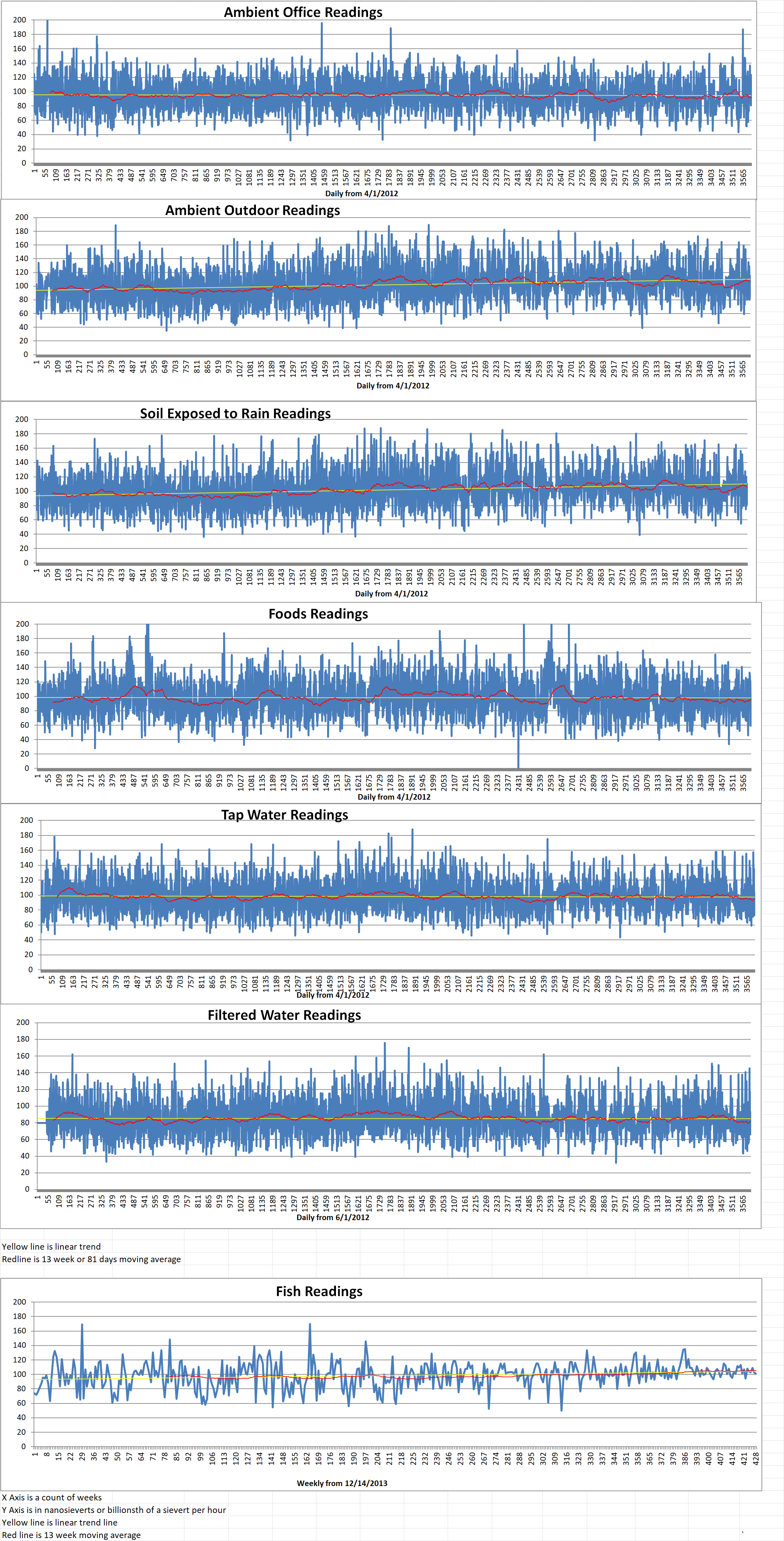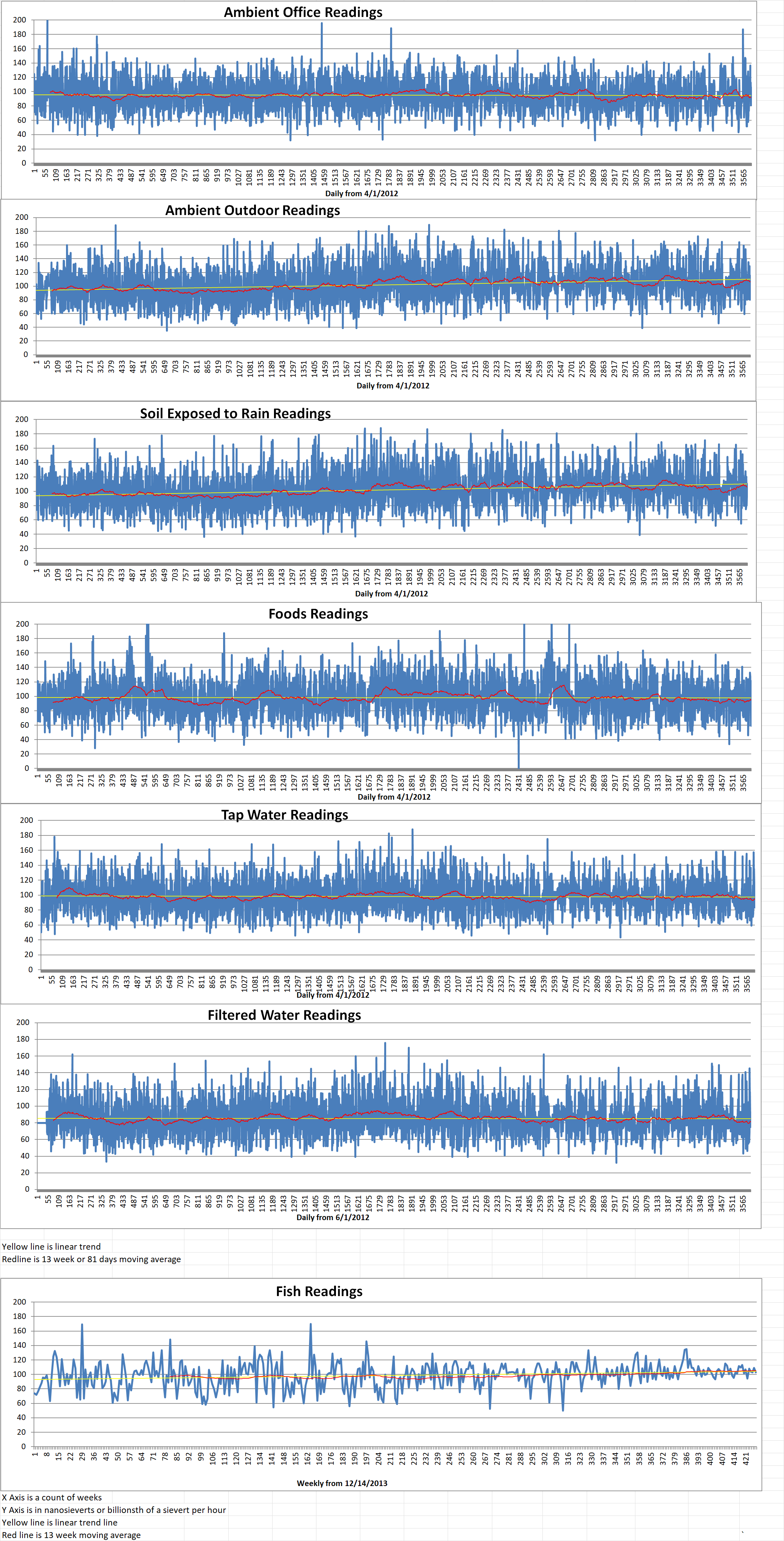Blog
-

Geiger Readings for May 15, 2022
Ambient office = 115 nanosieverts per hour
Ambient outside = 123 nanosieverts per hour
Soil exposed to rain water = 125 nanosieverts per hour
Blueberry from Central Market = 46 nanosieverts per hour
Tap water = 89 nanosieverts per hour
Filter water = 67 nanosieverts per hour
-
Nuclear News Roundup May 14, 2022
NNSA taking steps to extend contract with Consolidated Nuclear Security myhighplains.com
UK reprocessing plant to end operations world-nuclear-news.org
Nuclear power remains key sector for MHI world-nuclear-news.org
Environmentalists oppose more life for California nuke plant spectrumnews1.com
-

Geiger Readings for May 14, 2022
Ambient office = 123 nanosieverts per hour
Ambient outside = 85 nanosieverts per hour
Soil exposed to rain water = 83 nanosieverts per hour
Avocado from Central Market = 93 nanosieverts per hour
Tap water = 73 nanosieverts per hour
Filter water = 66 nanosieverts per hour
Dover sole = 101 nanosieverts per hour
-

Radioactive Waste 855 – Debate Rages Over Dumping Irradiated Wastewater Into Cape Cod Bay – Part 1 of 2 Parts
Part 1 of 2 Parts
It has been a contentious week for nuclear plant discussions among Massachusetts legislators and environmentalists debating the wisdom of discharging radioactive wastewater into Cape Cod Bay. The debate began last week on May 6th. U.S. Senator Edward J. Markey, a Democratic Senator from Massachusetts, convened an unusual field Senate subcommittee hearing in Plymouth Town Hall.
The hearing was sort of a preemptive strike to put the Nuclear Regulatory Commission (NRC) on notice that Massachusetts legislators and residents oppose proposed changes in rules governing the decommissioning of nuclear power plants in general and, in particular, the Pilgrim Nuclear Power Plant.
The hearing was confrontational at times. It involved grilling nuclear industry representatives and a lengthy interview with the CEO of Holtec International (HI). HI is the parent company of the Holtec subsidiary now dismantling the shuttered Pilgrim plant.
On May 9th, the NRC held the sixth and final of its national public meetings in Plymouth to outline those proposed rules. Environmentalists and legislators were unrestrained at the hearing. They said that the proposed rules would weaking federal oversight of the dismantling process and make it easier for private industry to cut corners.
The biggest apparent victory at the hearing came at the subcommittee hearing when Senator Markey was interviewing Holtec International’s CEO Krishan P. Singh. Mr. Singh repeatedly said that dumping as much as one million gallons of irradiated wastewater into Cape Cod Bay is one of three options that Holtec is considering to facilitate its site cleanup at Pilgrim. The water has been used over the years to cool the plant’s equipment. It would be cleansed and made safe before it was discharged into the Bay, according to Mr. Singh. He said that the levels of radiation would be far lower than the safe limits set by the Environmental Protection Agency (EPA). He added that “It does not raise concerns in people who are knowledgeable about the subject. It is not contaminated. It is processed water.”
Senator Markey responded to Singh testimony that the community would feel better if an independent body with fisheries expertise was contacted to evaluate the wastewater’s long-term potential effect on the delicate environment of Cape Cod Bay. Marky said that the Woods Hole Oceanographic Institution is world-renown and trusted by the people of Cape Cod and Plymouth. It would be an excellent choice to call in as an expert. Why not utilize WEHOI to test water samples and determine the safety of the processed water? Mr. Singh responded at the hearing that he would approve of such testing. He added “I think it’s a great addition.”
Mr. Singh sent a follow-up letter to Senator Markey’s office last Wednesday. In the letter, Mr. Singh reiterated his promise not to dump any radioactive wastewater into the Bay until WHOI determines that the level of radiation in the water would not affect marine life. In the letter, Mr. Singh said, “We will delay the completion of [the] decommissioning program, if need be, and hold the process[ed] water inside the plant for as long as necessary, if the expert scientific opinion advice is against discharging the remaining plant water into the bay.” Mr. Singh made other promises at the hearing. He claimed that he would work to improve communication with the community and the local labor unions.
Please read Part 2 next -
Nuclear News Roundup May 13, 2022
Putin’s worst nightmare MAPPED as ‘up to 100’ US nuclear weapons surround Russia’s border express.co.uk
Russia makes new threats over use of Satan-2 hypersonic nuclear missile on Britain independent.co.uk
Public invited to meeting on nuclear power plant exercise maryvilleforum.com
Jordan announces uranium production world-nuclear-news.org
-

Geiger Readings for May 13, 2022
Ambient office = 106 nanosieverts per hour
Ambient outside = 94 nanosieverts per hour
Soil exposed to rain water = 95 nanosieverts per hour
Tomato from Central Market = 88 nanosieverts per hour
Tap water = 103 nanosieverts per hour
Filter water = 93 nanosieverts per hour
-

Nuclear Reactors 1025 – Ohio Legislature Working On Bill To Stimulate Molten Salt Reactor Research and Development – Part 2 of 2 Parts
Part 2 of 2 Parts (Please read Part 1 first)
Under HB 434, the new state nuclear authority would perform “an essential government function [on] matters of public necessity for which public moneys may be spent and private property acquired.” The bill offers no estimate of how much money would ultimately be spent. Any fiscal impacts would not be known until an agreement with the NRC or the DoE.
Meetings of the nuclear authority would be considered public meetings. However, the nuclear authority could use staff or experts at the Ohio Department of Development. This state agency delegates many activities to JobsOhio. This institution is a statutorily created corporation that is exempt from Ohio’s public record law. Funding for JobsOhio comes for Ohio Liquor pursuant to a partnership with the Ohio Department of Commerce’s Division of Liquor Control. The Department of Development has not commented on what role JobsOhio might plant if HB 434 is enacted.
Peter Bradford is a former Nuclear Regulatory Commissioner who has also served as utility regulator in New York. He said, “It’s hard to know who’s going to be more disappointed — the citizens of Ohio if that bill becomes law and they actually spend any money trying to promote a molten-salt thorium-based reactor, or the promoters of the bill if anyone takes a serious look at how much it would cost actually to incubate a thorium fuel-cycle in Ohio.”
Bradford went on to say, “Nuclear power’s biggest problem is its cost,” and noted that thorium-based molten salt reactors are more expensive than other designs. He added. “Also, they are at least a decade away from being licensed and building a prototype, which would still have to prove itself to be reliable and economically competitive, which it is unlikely to be able to do.” He estimated it would take about ten billion dollars to build a prototype. However, it probably would not be able to produce electricity economically.
It is unclear what, if anything, the bill could actually authorize without approval from the NRC or the DoE. The nuclear authority would not be able to proceed with the construction of a molten salt reactor on its own without a permit from a U.S. federal agency. Stein said that a legislative resolution had requested a delegation of authority from the federal government. That has not happened yet.
Bradford said, “It’s not obvious really that [HB 434] does much more than lend comfort to the tub thumpers for thorium or small reactors generally.” Other designs for new reactors are closer to coming online than the molten salt reactor envisioned by HB 434 supporters. Gehin said, “A molten salt reactor isn’t going to be the next one over the finish line.”
Lyman and Bradford have mentioned that they found it odd for HB 434 to follow so soon on the heels of HB 6. HB 6 was the nuclear and coal bailout law at the heart of Ohio’s ongoing corruption scandal. Bradford said, “There’s simply no guardrails or safeguards against any of the abuses that Ohio citizens or customers have suffered in the last five or six years, which is pretty breathtaking.” Lyman said, “You’d think after that fiasco the legislature would be a little more cautious.”
HB 434 passed in the Ohio House at the end of March 2022. No hearings have been scheduled yet in the Ohio Senate’s Energy and Public Utilities Committee. -
Nuclear News Roundup May 12, 2022
How Ukraine war influenced the SNP’s NATO position bbc.com
TVA eyes late 2023 or early 2024 for SMR license application world-nuclear-news.com
French scientist leading nuclear fusion project dies at 72 abcnews.com
Putin health bombshell: Top commanders would ‘ignore’ nuclear order as he is ‘gravely ill’ express.co.uk
-

Geiger Readings for May 12, 2022
Ambient office = 81 nanosieverts per hour
Ambient outside = 115 nanosieverts per hour
Soil exposed to rain water = 111 nanosieverts per hour
Red leaf lettuce from Central Market = 59 nanosieverts per hour
Tap water = 83 nanosieverts per hour
Filter water = 75 nanosieverts per hour
